Libo Zhang
National University of Defense Technology, Changsha, China
G3CN: Gaussian Topology Refinement Gated Graph Convolutional Network for Skeleton-Based Action Recognition
Sep 09, 2025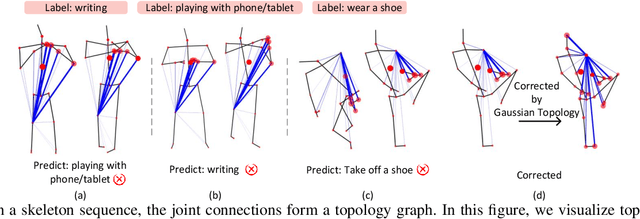
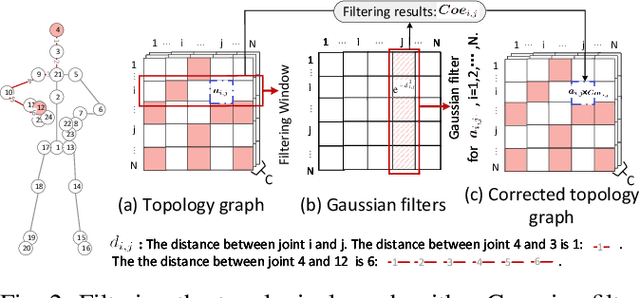
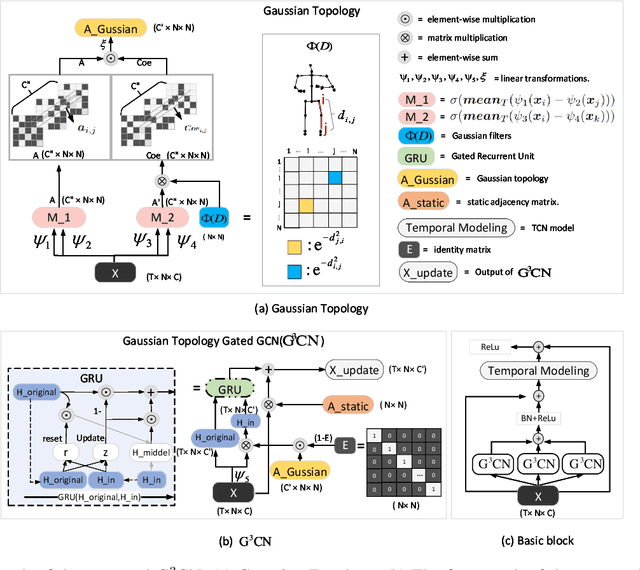

Abstract:Graph Convolutional Networks (GCNs) have proven to be highly effective for skeleton-based action recognition, primarily due to their ability to leverage graph topology for feature aggregation, a key factor in extracting meaningful representations. However, despite their success, GCNs often struggle to effectively distinguish between ambiguous actions, revealing limitations in the representation of learned topological and spatial features. To address this challenge, we propose a novel approach, Gaussian Topology Refinement Gated Graph Convolution (G$^{3}$CN), to address the challenge of distinguishing ambiguous actions in skeleton-based action recognition. G$^{3}$CN incorporates a Gaussian filter to refine the skeleton topology graph, improving the representation of ambiguous actions. Additionally, Gated Recurrent Units (GRUs) are integrated into the GCN framework to enhance information propagation between skeleton points. Our method shows strong generalization across various GCN backbones. Extensive experiments on NTU RGB+D, NTU RGB+D 120, and NW-UCLA benchmarks demonstrate that G$^{3}$CN effectively improves action recognition, particularly for ambiguous samples.
Meta-Inverse Reinforcement Learning for Mean Field Games via Probabilistic Context Variables
Sep 04, 2025Abstract:Designing suitable reward functions for numerous interacting intelligent agents is challenging in real-world applications. Inverse reinforcement learning (IRL) in mean field games (MFGs) offers a practical framework to infer reward functions from expert demonstrations. While promising, the assumption of agent homogeneity limits the capability of existing methods to handle demonstrations with heterogeneous and unknown objectives, which are common in practice. To this end, we propose a deep latent variable MFG model and an associated IRL method. Critically, our method can infer rewards from different yet structurally similar tasks without prior knowledge about underlying contexts or modifying the MFG model itself. Our experiments, conducted on simulated scenarios and a real-world spatial taxi-ride pricing problem, demonstrate the superiority of our approach over state-of-the-art IRL methods in MFGs.
OS-R1: Agentic Operating System Kernel Tuning with Reinforcement Learning
Aug 18, 2025Abstract:Linux kernel tuning is essential for optimizing operating system (OS) performance. However, existing methods often face challenges in terms of efficiency, scalability, and generalization. This paper introduces OS-R1, an agentic Linux kernel tuning framework powered by rule-based reinforcement learning (RL). By abstracting the kernel configuration space as an RL environment, OS-R1 facilitates efficient exploration by large language models (LLMs) and ensures accurate configuration modifications. Additionally, custom reward functions are designed to enhance reasoning standardization, configuration modification accuracy, and system performance awareness of the LLMs. Furthermore, we propose a two-phase training process that accelerates convergence and minimizes retraining across diverse tuning scenarios. Experimental results show that OS-R1 significantly outperforms existing baseline methods, achieving up to 5.6% performance improvement over heuristic tuning and maintaining high data efficiency. Notably, OS-R1 is adaptable across various real-world applications, demonstrating its potential for practical deployment in diverse environments. Our dataset and code are publicly available at https://github.com/LHY-24/OS-R1.
Situational-Constrained Sequential Resources Allocation via Reinforcement Learning
Jun 17, 2025



Abstract:Sequential Resource Allocation with situational constraints presents a significant challenge in real-world applications, where resource demands and priorities are context-dependent. This paper introduces a novel framework, SCRL, to address this problem. We formalize situational constraints as logic implications and develop a new algorithm that dynamically penalizes constraint violations. To handle situational constraints effectively, we propose a probabilistic selection mechanism to overcome limitations of traditional constraint reinforcement learning (CRL) approaches. We evaluate SCRL across two scenarios: medical resource allocation during a pandemic and pesticide distribution in agriculture. Experiments demonstrate that SCRL outperforms existing baselines in satisfying constraints while maintaining high resource efficiency, showcasing its potential for real-world, context-sensitive decision-making tasks.
CGTrack: Cascade Gating Network with Hierarchical Feature Aggregation for UAV Tracking
May 09, 2025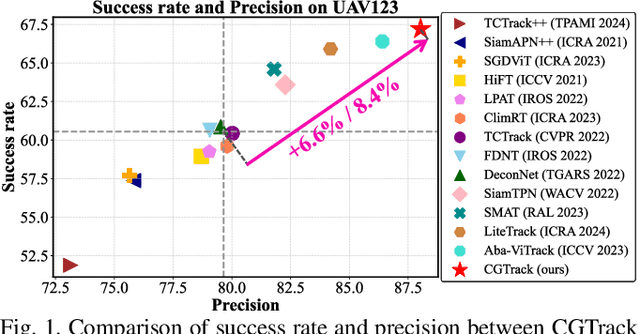

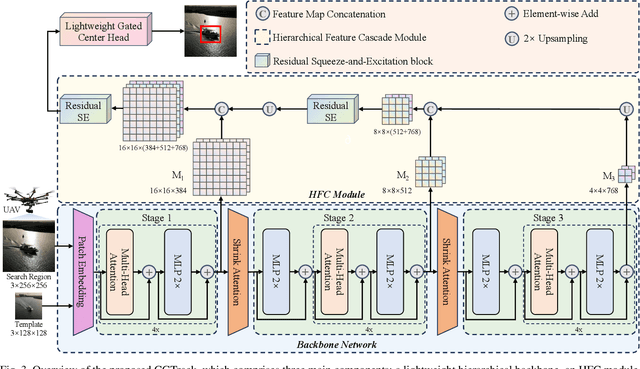
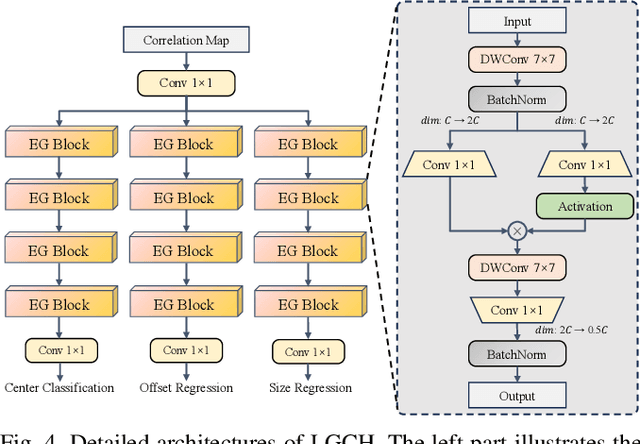
Abstract:Recent advancements in visual object tracking have markedly improved the capabilities of unmanned aerial vehicle (UAV) tracking, which is a critical component in real-world robotics applications. While the integration of hierarchical lightweight networks has become a prevalent strategy for enhancing efficiency in UAV tracking, it often results in a significant drop in network capacity, which further exacerbates challenges in UAV scenarios, such as frequent occlusions and extreme changes in viewing angles. To address these issues, we introduce a novel family of UAV trackers, termed CGTrack, which combines explicit and implicit techniques to expand network capacity within a coarse-to-fine framework. Specifically, we first introduce a Hierarchical Feature Cascade (HFC) module that leverages the spirit of feature reuse to increase network capacity by integrating the deep semantic cues with the rich spatial information, incurring minimal computational costs while enhancing feature representation. Based on this, we design a novel Lightweight Gated Center Head (LGCH) that utilizes gating mechanisms to decouple target-oriented coordinates from previously expanded features, which contain dense local discriminative information. Extensive experiments on three challenging UAV tracking benchmarks demonstrate that CGTrack achieves state-of-the-art performance while running fast. Code will be available at https://github.com/Nightwatch-Fox11/CGTrack.
High-Fidelity Image Inpainting with Multimodal Guided GAN Inversion
Apr 17, 2025Abstract:Generative Adversarial Network (GAN) inversion have demonstrated excellent performance in image inpainting that aims to restore lost or damaged image texture using its unmasked content. Previous GAN inversion-based methods usually utilize well-trained GAN models as effective priors to generate the realistic regions for missing holes. Despite excellence, they ignore a hard constraint that the unmasked regions in the input and the output should be the same, resulting in a gap between GAN inversion and image inpainting and thus degrading the performance. Besides, existing GAN inversion approaches often consider a single modality of the input image, neglecting other auxiliary cues in images for improvements. Addressing these problems, we propose a novel GAN inversion approach, dubbed MMInvertFill, for image inpainting. MMInvertFill contains primarily a multimodal guided encoder with a pre-modulation and a GAN generator with F&W+ latent space. Specifically, the multimodal encoder aims to enhance the multi-scale structures with additional semantic segmentation edge texture modalities through a gated mask-aware attention module. Afterwards, a pre-modulation is presented to encode these structures into style vectors. To mitigate issues of conspicuous color discrepancy and semantic inconsistency, we introduce the F&W+ latent space to bridge the gap between GAN inversion and image inpainting. Furthermore, in order to reconstruct faithful and photorealistic images, we devise a simple yet effective Soft-update Mean Latent module to capture more diversified in-domain patterns for generating high-fidelity textures for massive corruptions. In our extensive experiments on six challenging datasets, we show that our MMInvertFill qualitatively and quantitatively outperforms other state-of-the-arts and it supports the completion of out-of-domain images effectively.
OmniSTVG: Toward Spatio-Temporal Omni-Object Video Grounding
Mar 13, 2025Abstract:In this paper, we propose spatio-temporal omni-object video grounding, dubbed OmniSTVG, a new STVG task that aims at localizing spatially and temporally all targets mentioned in the textual query from videos. Compared to classic STVG locating only a single target, OmniSTVG enables localization of not only an arbitrary number of text-referred targets but also their interacting counterparts in the query from the video, making it more flexible and practical in real scenarios for comprehensive understanding. In order to facilitate exploration of OmniSTVG, we introduce BOSTVG, a large-scale benchmark dedicated to OmniSTVG. Specifically, our BOSTVG consists of 10,018 videos with 10.2M frames and covers a wide selection of 287 classes from diverse scenarios. Each sequence in BOSTVG, paired with a free-form textual query, encompasses a varying number of targets ranging from 1 to 10. To ensure high quality, each video is manually annotated with meticulous inspection and refinement. To our best knowledge, BOSTVG is to date the first and the largest benchmark for OmniSTVG. To encourage future research, we introduce a simple yet effective approach, named OmniTube, which, drawing inspiration from Transformer-based STVG methods, is specially designed for OmniSTVG and demonstrates promising results. By releasing BOSTVG, we hope to go beyond classic STVG by locating every object appearing in the query for more comprehensive understanding, opening up a new direction for STVG. Our benchmark, model, and results will be released at https://github.com/JellyYao3000/OmniSTVG.
Attention to Trajectory: Trajectory-Aware Open-Vocabulary Tracking
Mar 11, 2025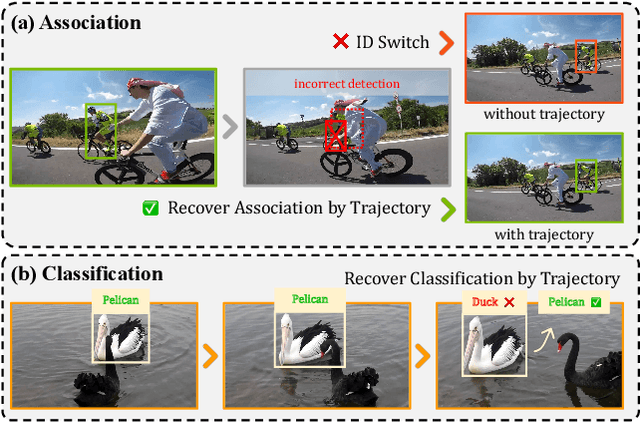


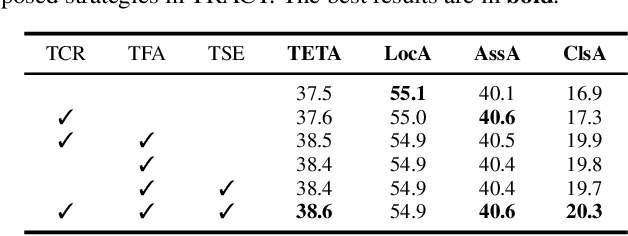
Abstract:Open-Vocabulary Multi-Object Tracking (OV-MOT) aims to enable approaches to track objects without being limited to a predefined set of categories. Current OV-MOT methods typically rely primarily on instance-level detection and association, often overlooking trajectory information that is unique and essential for object tracking tasks. Utilizing trajectory information can enhance association stability and classification accuracy, especially in cases of occlusion and category ambiguity, thereby improving adaptability to novel classes. Thus motivated, in this paper we propose \textbf{TRACT}, an open-vocabulary tracker that leverages trajectory information to improve both object association and classification in OV-MOT. Specifically, we introduce a \textit{Trajectory Consistency Reinforcement} (\textbf{TCR}) strategy, that benefits tracking performance by improving target identity and category consistency. In addition, we present \textbf{TraCLIP}, a plug-and-play trajectory classification module. It integrates \textit{Trajectory Feature Aggregation} (\textbf{TFA}) and \textit{Trajectory Semantic Enrichment} (\textbf{TSE}) strategies to fully leverage trajectory information from visual and language perspectives for enhancing the classification results. Extensive experiments on OV-TAO show that our TRACT significantly improves tracking performance, highlighting trajectory information as a valuable asset for OV-MOT. Code will be released.
KGCompiler: Deep Learning Compilation Optimization for Knowledge Graph Complex Logical Query Answering
Mar 04, 2025
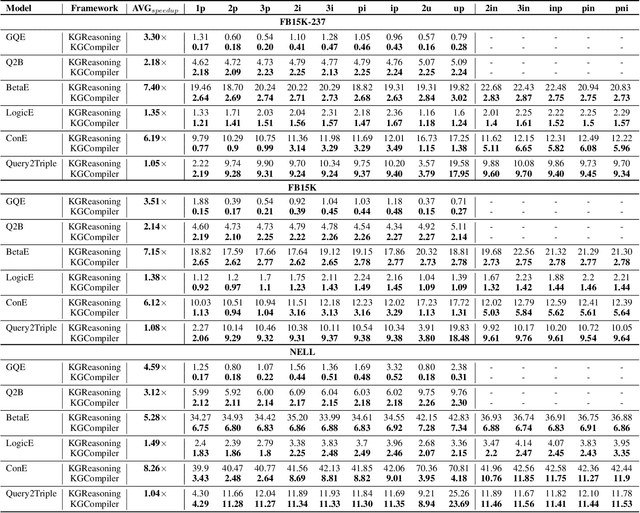


Abstract:Complex Logical Query Answering (CLQA) involves intricate multi-hop logical reasoning over large-scale and potentially incomplete Knowledge Graphs (KGs). Although existing CLQA algorithms achieve high accuracy in answering such queries, their reasoning time and memory usage scale significantly with the number of First-Order Logic (FOL) operators involved, creating serious challenges for practical deployment. In addition, current research primarily focuses on algorithm-level optimizations for CLQA tasks, often overlooking compiler-level optimizations, which can offer greater generality and scalability. To address these limitations, we introduce a Knowledge Graph Compiler, namely KGCompiler, the first deep learning compiler specifically designed for CLQA tasks. By incorporating KG-specific optimizations proposed in this paper, KGCompiler enhances the reasoning performance of CLQA algorithms without requiring additional manual modifications to their implementations. At the same time, it significantly reduces memory usage. Extensive experiments demonstrate that KGCompiler accelerates CLQA algorithms by factors ranging from 1.04x to 8.26x, with an average speedup of 3.71x. We also provide an interface to enable hands-on experience with KGCompiler.
Dovetail: A CPU/GPU Heterogeneous Speculative Decoding for LLM inference
Dec 25, 2024Abstract:Due to the high resource demands of Large Language Models (LLMs), achieving widespread deployment on consumer-grade devices presents significant challenges. Typically, personal or consumer-grade devices, including servers configured prior to the era of large-scale models, generally have relatively weak GPUs and relatively strong CPUs. However, most current methods primarily depend on GPUs for computation. Therefore, we propose Dovetail, an approach that deploys the draft model on the GPU to generate draft tokens while allowing the target model to perform parallel verification on the CPU, thereby improving the utilization of all available hardware resources and occupying less inter-device communication bandwidth. Accordingly, we have redesigned the draft model to better align with heterogeneous hardware characteristics. To this end, we implemented several optimizations: reducing the number of draft tokens to mitigate latency in parallel verification, increasing the depth of the draft model to enhance its predictive capacity, and introducing DGF (Dynamic Gating Fusion) to improve the integration of features and token embeddings. In the HumanEval benchmark, Dovetail achieved an inference speed of 5.86 tokens per second for LLaMA2-Chat-7B using 3GB of VRAM, representing an approximately 2.77x improvement over CPU-only inference. Furthermore, the inference speed was increased to 8 tokens per second when utilizing 7GB of VRAM.
 Add to Chrome
Add to Chrome Add to Firefox
Add to Firefox Add to Edge
Add to Edge